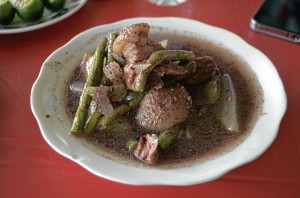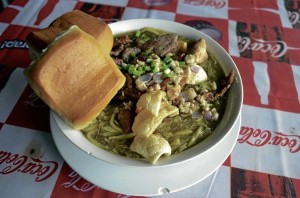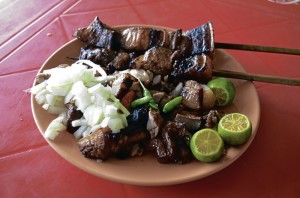
We stopped at the entrance marker of Cuenca, Batangas, which says “Home of the Bakers.” Our guide was a true son of the town, Lucito Chavez. His family used to have a small bakery, but he decided to open his own in Manila, called Tinapayan Festival, near the University of Santo Tomas.
If you go to many bakeries today, you will, more often than not, be told that their master baker comes from Cuenca. The baking skill is passed on from father to son or nephew or cousin, and is not dependent on culinary diplomas, just apprenticeship. The Tinapayan Festival, held in November, is a celebration of Cuenca’s major product, and a tribute to the people who make them.
‘Burdado’
We visited many panaderia (traditional bakeries), some still using pugon, or antique wood-fed ovens. Familiar breads like monay, kababayan and pan de limon were sold to buyers who came nonstop, though in trickles, at the time we were there, almost at noon.
Most buyers come in force in the early morning for their breakfast pan de sal and in late afternoon for merienda. Chavez acquainted us with breads we didn’t know about, such as burdado, a mamon that has an artistic curlicue design on top done with sugar icing.
But my attention was diverted to the food that was still done the traditional way.
Chavez’s favorite place for lomi is called “Glowing Sunrise.” It doesn’t give you a hint that this is where you can get perhaps the richest lomi I have ever tasted. It’s loaded with fat noodles and slices of pork and innards. If you don’t know the recipe but can discern what went into it, you can guess that lots of starch and beaten egg make for thick consistency.

You need only a small bowl to get really full. Then you cut down the rich flavors with the bland pan de agua, its partner bread. Maybe that bread got its name because water, at least good water, should be tasteless. And perhaps the undulating top represents waves.
Cubes of pork
A bit of a walk and we were following our nose toward the aroma of barbecue cooking. At Inday Ludy’s, the grill is constantly working. But the barbecue, again, is not the teeny-weeny bits we sometimes buy, but cubes of pork.
It used to be bigger, said Chavez, so that the parts already cooked were sliced off, then the still uncooked insides put back on the grill. His eyes smiled at the thought of the time, years ago, when you got more than your money’s worth.
The taste is mainly of pork and a bit of seasoning, no marinade and no basting. It’s the pork that makes this barbecue so good, Chavez said. There’s nothing like pork from Cuenca, according to him, and he will never buy pork anywhere. He has his vehicles travel there to get pork for his restaurant at Tinapayan Festival.
Goto was ordered. In Batangas, this is soup with beef tripe, and sometimes whole head mixed in. In the market of Lemery, deep pots simmer with goto, the soup colored orange with annatto or achuete. Goto in Cuenca was much the same, but the cuts were regular-sized rather than the haphazard sizes in Lemery, because the seller there used scissors to cut the pieces.

The taste was simple broth, not heavy with seasoning at all. That should be Batangas cooking for you, quite straightforward.
Suddenly, Chavez remembered a dish he hadn’t had for a long time. He asked if Inday Ludy’s cooked sinangaok. It was a strange name. It was broth with chunks of pork with fat, a bit dark with sitaw (yardlong beans) and labanos (radish). Chavez explained that the cooking is also called kinamatisan, cooked with tomatoes in the broth, which also has a bit of pork blood.
It has a slightly sour flavor because of the tomatoes, like the tinola in the Visayas that usually uses tomato as the souring agent. His mother, Chavez said, added slices of sayote and okra.
Tastings
While we took all these food and information in, we were told Inay Ludy’s real name is Ma. Salud Atienza, who cooked these food when she started her restaurant in 1981. Her heirs have continued the business, keeping the food as it must have been from its opening—well, except that the pork cuts in the barbecue used to be bigger.
But guess what? All those food weren’t supposed to be our lunch, merely tastings. We were going to another place—though we had had too much already. Next visit, Chavez said we would go to where the cooking uses a lot of pupor, those crunchy bits that result from rendering pork fat.
Pork lard, after all, is used in bakeries to make traditional cookies and pastries like ensaymada. In Iloilo where several panaderia can be found, those crunchy bits or chitterlings can also be found and are sold to restaurants.
Called tulapo, these are used as toppings for vegetable dishes, adding flavor and texture. Of course you can eat those as is. I wonder if this is the same as chicharon Bisaya.
E-mail [email protected]













































